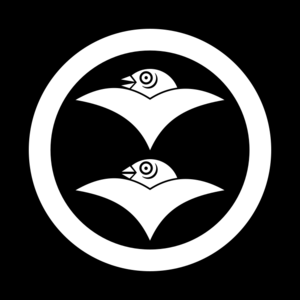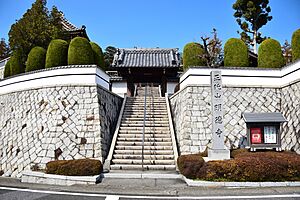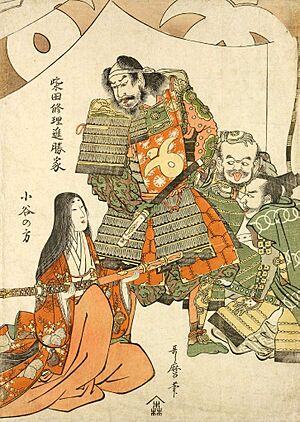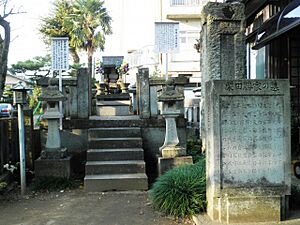Shibata Katsuie facts for kids
Quick facts for kids
Shibata Katsuie
|
|||||
|---|---|---|---|---|---|
| 柴田 勝家 | |||||
 |
|||||
| Lord of Tsuruga | |||||
| In office 1575–1583 |
|||||
| Succeeded by | Hachiya Yoritaka | ||||
| Lord of Kitanosho Castle | |||||
| In office 1575–1583 |
|||||
| Personal details | |||||
| Born | 1522 Kamiyashiro, Nagoya, Owari Province |
||||
| Died | June 14, 1583 (aged 60–61) Kitanosho Castle, Echizen Province |
||||
| Spouse | Oichi | ||||
| Relations | Oda Nobunaga (brother in law) | ||||
| Children | Shibata Katsutoyo [jp] (adopted son) Shibata Katsumasa (adopted son) Yodo-dono (step daughter) Ohatsu (step daughter) Oeyo (step daughter) |
||||
| Nicknames | "Oni Shibata" (demon shibata) "Gonroku" |
||||
| Military service | |||||
| Allegiance | |||||
| Unit | |||||
| Commands | Kitanosho Castle | ||||
| Battles/wars | Battle of Kiyosu Castle Battle of Ino Battle of Okehazama Siege of Inabayama Siege of Shōryūji Castle Siege of Chōkō-ji Siege of Nagashima Siege of Ichijōdani Castle Echizen Campaign Battle of Nagashino Hokuriku Campaign Battle of Tedorigawa Kaga Campaign Siege of Uozu Battle of Shizugatake |
||||
| Japanese name | |||||
| Kanji | 柴田 勝家 | ||||
| Hiragana | しばた かついえ | ||||
|
|||||
Shibata Katsuie (born in 1522, died June 14, 1583) was a famous Japanese samurai and military leader. He lived during the Sengoku period, a time when Japan was often at war. Katsuie was a very trusted general who worked for Oda Nobunaga, one of the most powerful leaders of that time. He was known for his bravery and loyalty in many important battles. People sometimes called him "Oni Shibata," which means "Demon Shibata," because of his fierce fighting style.
Contents
Early Life and Loyalty
Katsuie was born in a village called Kamiyashiro, which is now part of Nagoya. His family was a branch of the Shiba clan, who were once very important leaders.
At first, Katsuie served Oda Nobuyuki, who was the younger brother of Oda Nobunaga. In 1554, Katsuie fought in the Battle of Kiyosu Castle against Nobunaga's uncle, Oda Nobutomo.
In 1556, there was a disagreement over who should lead the Oda clan. Katsuie supported Nobuyuki against his older brother, Nobunaga. Katsuie even tried to take control from Nobunaga. He was defeated in the Battle of Inō. After this, Nobunaga had his brother Nobuyuki executed. However, Nobunaga was so impressed by Katsuie's loyalty and courage that he spared Katsuie's life. Katsuie then promised to serve Nobunaga, and Nobunaga praised him for his bravery.
Serving Oda Nobunaga
Katsuie became a key general for Nobunaga. In 1560, he led Nobunaga's main forces in the famous Battle of Okehazama against Imagawa Yoshimoto. This battle was a big victory for Nobunaga.
In 1567, Katsuie led the first group of Nobunaga's soldiers in the Siege of Inabayama, a battle against the Saito clan.
Later, in 1568, Katsuie and other generals attacked Iwanari Tomomichi at Shōryūji Castle.
In 1570, while Nobunaga's army was fighting in the Battle of Anegawa, Katsuie was at Chōkō-ji castle. His castle was surrounded by 4,000 soldiers from the Rokkaku clan. Katsuie launched a surprise attack and won, forcing the Rokkaku to retreat. This victory, along with others, helped him earn the nickname "Demon Shibata."
In 1571, Katsuie was badly hurt during the first Siege of Nagashima.
In 1573, the Shogun, Ashikaga Yoshiaki, tried to form a group against Nobunaga. Katsuie fought against Yoshiaki's forces in different areas as a strong commander in Nobunaga's army. He also took part in the Siege of Ichijodani Castle and the second Siege of Nagashima.
In 1574, he was part of the third Siege of Nagashima, commanding a group of soldiers.
In 1575, Katsuie fought in the Battle of Nagashino against Takeda Katsuyori. He and Toyotomi Hideyoshi protected the left side of the army.
After Nobunaga gained control of Echizen Province in 1576, Katsuie was put in charge of Kitanosho Castle. He was then given the important job of conquering the Hokuriku region.
In 1577, Nobunaga sent Katsuie and other experienced generals to help fight Uesugi Kenshin at the Battle of Tedorigawa.
By 1580, Katsuie led his army, including his general Sakuma Morimasa, to fight against the Kaga Ikko-ikki at Kanazawa.
In 1581, after taking control of Noto Province, Katsuie began a campaign to conquer Etchū Province. He worked with other generals like Maeda Toshiie and Sassa Narimasa.
Death of Nobunaga
In 1582, Katsuie and Sassa Narimasa successfully surrounded and captured Uozu Castle and Matsukura Castle. While they were doing this, a terrible event happened. Oda Nobunaga and his oldest son, Oda Nobutada, were killed by the forces of Akechi Mitsuhide in an event known as the Honnō-ji incident.
Katsuie's Final Battle
After Nobunaga's death in 1582, a meeting was held at Kiyosu Castle to decide who would be Nobunaga's successor. Katsuie first supported Nobunaga's grandson, Samboshi. However, he later supported Oda Nobutaka, Nobunaga's third son.
Katsuie then joined forces with Oda Nobutaka and Takigawa Kazumasu. They were against Toyotomi Hideyoshi, who had allied with Oda Nobukatsu. Tensions quickly grew between Hideyoshi and Katsuie. The next year, they fought in a major battle called the Battle of Shizugatake.
Battle of Shizugatake
In 1583, Katsuie sent his nephew, Sakuma Morimasa, to attack Takayama Ukon and Nakagawa Kiyohide at Shizugatake. Morimasa did not follow Katsuie's orders to retreat and was captured by Hideyoshi's returning army.
Katsuie's forces were defeated. He retreated back to Kitanosho Castle in Echizen. Hideyoshi's army quickly surrounded the castle and captured it in just three days.
During the siege, Katsuie asked his wife, Oichi, to take her daughters and leave for safety. However, Oichi chose to stay and die with him, but she made sure her daughters escaped. After setting his castle on fire, Katsuie performed seppuku, a ritual suicide.
His last poem was: Natsu no yo no yumeji hakanaki ato no na o kumoi ni ageyo yamahototogisu
This poem means: "Fleeting dream paths, In the summer night! O bird of the mountain, Carry my name beyond the clouds."
Family Connections
- Wife: Oichi (1547–1583)
- Step-daughters (Oichi's daughters from her first marriage):
- Yodo-dono (1569–1615)
- Ohatsu (1570–1633)
- Oeyo (1573–1626)
- Adopted sons:
- Shibata Katsutoyo
- Shibata Katsumasa
See also
- People of the Sengoku period in popular culture § Shibata Katsuie
- The Kiyosu Conference (2013 film)





